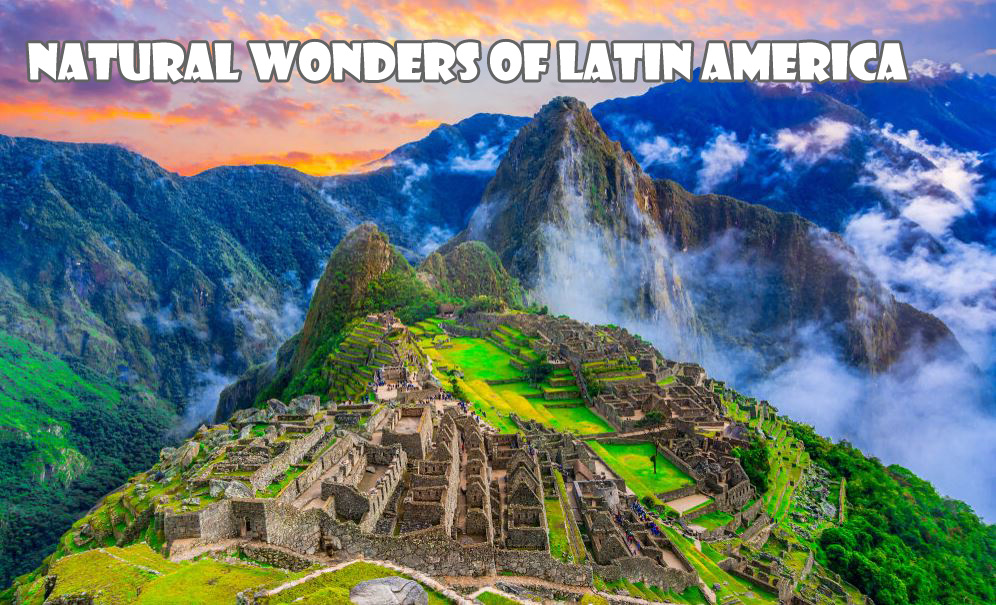The “natural wonders of Latin America” refers to the most impressive and significant natural landmarks, landscapes, and phenomena found in the countries of Latin America. These can include physical features like mountains, deserts, and waterfalls, as well as ecosystems like rainforests and coral reefs. The term “natural wonders” suggests that these features are unique, extraordinary, and deserving of special attention and appreciation. Some examples of natural wonders of Latin America might include the Iguazu Falls, the Galapagos Islands, the Amazon Rainforest, and the Atacama Desert. These natural wonders are often popular tourist destinations due to their beauty and ecological importance.
Natural Wonders of Latin America
The Latin American region has an amazing reputation for being rich in natural beauty, home to some of the world’s most stunning natural wonders that are sure to take your breath away. Latin America has so many wonders of landscape, wildlife, geographical formations and natural wonders that make the region a destination that if or if you must visit at least once in a lifetime. Meet the 10 most incredible natural wonders of Larina America:
Caño Cristales, Colombia
Caño Cristales is a river in Colombia that is known for its striking, vibrant colors. It is often referred to as the “River of Five Colors” or the “Liquid Rainbow.” The colors are caused by the presence of various types of algae and plants that grow on the riverbed. The most striking colors are shades of yellow, green, blue, and red, which can be seen from June to November. The rest of the year, the river appears a more subdued brown color. Caño Cristales is located in the Serranía de la Macarena mountain range in the Meta Department of Colombia. It is a popular destination for tourists, but access to the area is restricted to protect the delicate ecosystem of the river.
Angel Falls, Venezuela
Angel Falls is the highest waterfall in the world, with a height of 979 meters (3,212 feet). It is located in the Canaima National Park in Venezuela, and is named after the American aviator James Angel, who flew over the falls in 1933. The falls are formed by the Carrao River, which flows over the edge of a sandstone cliff and into a deep gorge below. The falls are best viewed from the air, as they are located in a remote, difficult-to-access part of the country. The area around the falls is home to a variety of plant and animal life, including several species of orchid and a number of threatened or endangered animals, such as the giant otter and the giant anteater.
Atacama Desert, Chile
The Atacama Desert is a large desert located in Chile, South America. It is known for being the driest desert in the world, with some areas that have not received any measurable rainfall in over 400 years. Despite its dryness, the Atacama Desert is home to a variety of plant and animal life that has adapted to the harsh conditions. The desert is also home to a number of important resources, including copper, lithium, and other minerals. The Atacama Desert is a popular destination for tourists, who come to see its unique landscapes and to participate in activities such as sandboarding and stargazing. The desert is also home to several indigenous communities, who have lived in the area for centuries and have developed a deep connection to the land.
Salar de Uyuni, Bolivia
Salar de Uyuni is a large salt flat located in Bolivia, South America. It is the largest salt flat in the world, covering an area of over 4,000 square miles. Salar de Uyuni was formed when a prehistoric lake dried up, leaving behind a layer of salt that is over 10 meters (33 feet) thick in some places. The salt flat is a unique and otherworldly landscape, with a seemingly endless expanse of white salt that reflects the sky and creates the illusion of a vast, mirror-like surface. During the rainy season, a thin layer of water covers the salt flat, creating a perfect reflection of the clouds and sky above. Salar de Uyuni is a popular destination for tourists, who come to see its unique landscapes and to participate in activities such as 4×4 driving and photography. The salt flat is also home to several species of flamingos, which feed on the brine shrimp that live in the shallow ponds on the surface of the salt flat.
Perito Moreno, Argentina
Perito Moreno is a glacier located in Argentina, South America. It is part of the Southern Patagonian Ice Field, which is the third largest ice field in the world. Perito Moreno is one of the few glaciers in the world that is still growing, and it is a popular tourist destination due to its accessibility and the dramatic way in which it calves, or breaks off, into the lake below. The glacier is named after the Argentine explorer Francisco Moreno, who played a key role in the survey and mapping of Patagonia. The Perito Moreno glacier is located in the Los Glaciares National Park, which is a UNESCO World Heritage Site. The park is home to a number of other glaciers, as well as a diverse array of plant and animal life.
The Amazon rainforest
The Amazon rainforest is a vast expanse of tropical rainforest located in the Amazon Basin in South America. It is the largest rainforest in the world, covering an area of approximately 6.7 million square kilometers (2.7 million square miles). The Amazon rainforest is home to an incredible diversity of plant and animal life, including thousands of species of trees, plants, and animals that are found nowhere else on earth. The rainforest is also home to a number of indigenous communities, who have lived in the region for centuries and have developed a deep connection to the land.
The Amazon rainforest is important for a number of reasons. It plays a key role in regulating the global climate, as the trees and plants in the rainforest absorb and store large amounts of carbon dioxide. The rainforest is also a source of many important resources, including timber, rubber, and medicinal plants. Despite its importance, the Amazon rainforest is under threat from activities such as logging, mining, and agriculture, which can damage or destroy the forest and the ecosystems it supports. There are efforts underway to protect and conserve the Amazon rainforest, including the creation of protected areas and the promotion of sustainable development practices.
Galapagos Islands, Ecuador
The Galapagos Islands are an archipelago of volcanic islands located in the Pacific Ocean, about 1,000 kilometers (620 miles) off the coast of Ecuador, South America. The islands are known for their unique and diverse plant and animal life, much of which is found nowhere else on earth. The Galapagos Islands are home to a number of species that have evolved in isolation from the mainland, leading to the development of unique characteristics and adaptations.
The Galapagos Islands are best known for their role in the development of Charles Darwin’s theory of evolution by natural selection. Darwin visited the islands in 1835 and was struck by the unique species he encountered there, which played a key role in the development of his theory. The Galapagos Islands were declared a UNESCO World Heritage Site in 1978, and they are now a popular destination for tourists, who come to see the unique plant and animal life and to learn about the islands’ role in the history of science. The Galapagos Islands are also home to a number of protected areas and conservation efforts, which aim to protect the islands’ fragile ecosystems and the species that depend on them.
Huacachina Lagoon, Peru
Huacachina Lagoon is a small oasis located in the desert of Peru, South America. It is located in the Ica Region, about 5 hours south of Lima. Huacachina Lagoon is a popular destination for tourists, who come to see the small oasis surrounded by towering sand dunes. The lagoon is home to a number of palm trees and other vegetation, and it is surrounded by small hotels and restaurants.
Huacachina Lagoon is a popular spot for sandboarding and dune buggy rides, as the surrounding sand dunes offer a unique and thrilling experience. The lagoon is also home to a number of species of birds, including flamingos, which can be seen in the area. The lagoon is a beautiful and serene spot, and it offers a welcome respite from the hot, dry desert that surrounds it.
Lake Titicaca, Bolivia and Peru
Lake Titicaca is a large, high-altitude lake located in the Andes Mountains, on the border between Bolivia and Peru. It is the highest navigable lake in the world, at an elevation of 3,812 meters (12,507 feet) above sea level. Lake Titicaca is home to a number of indigenous communities, who have lived in the region for centuries and have developed a deep connection to the lake and its surrounding environment. The lake is also home to a number of unique species of fish and other animals that are found nowhere else on earth.
Lake Titicaca is an important cultural and spiritual site for the indigenous people of the region, and it is a popular destination for tourists, who come to see the lake and to learn about the culture and history of the area. The lake is home to a number of islands, including the floating islands of the Uros people, which are made of reeds and other vegetation and have been inhabited for centuries. The lake is also home to the ruins of the ancient city of Tiahuanaco, which was an important center of the Tiwanaku civilization.
Iguazu Falls, Argentina
Iguazu Falls is a large waterfall system located on the border between Argentina and Brazil. It is one of the largest and most spectacular waterfall systems in the world, and it is a UNESCO World Heritage Site. The falls are formed by the Iguazu River, which flows over the edge of a basalt cliff and into a deep gorge below. The falls are made up of a series of cascades, which together have a total width of almost 2.7 kilometers (1.7 miles). The highest and most spectacular of the falls is the Devil’s Throat, which is a U-shaped cascade that is 82 meters (269 feet) high.
Iguazu Falls is a popular destination for tourists, who come to see the falls and to participate in activities such as boat tours and hiking. The falls are also home to a number of plant and animal species, including several threatened or endangered species such as the jaguar and the giant otter. The falls are surrounded by the Iguazu National Park, which is home to a variety of ecosystems, including rainforests, savannas, and wetlands. The park is home to a number of protected areas and conservation efforts, which aim to protect the falls and the surrounding environment.
Patagonia, South America
Patagonia is a region located in the southern part of South America, shared by Argentina and Chile. It is known for its rugged, wild landscapes, which include mountains, forests, and glaciers. Patagonia is home to a number of national parks and protected areas, which are popular destinations for tourists who come to see the region’s natural beauty.
The landscape of Patagonia is shaped by the Andes Mountains, which run through the region from north to south. The region is home to a number of large glaciers, including the Perito Moreno glacier in Argentina and the Grey Glacier in Chile. Patagonia is also home to a variety of plant and animal life, including several species that are found nowhere else on earth.
Patagonia is a popular destination for outdoor enthusiasts, who come to the region to participate in activities such as hiking, climbing, and skiing. The region is also home to a number of small towns and villages, which offer a glimpse into the local culture and way of life.
The Andes Mountains
The Andes Mountains are the longest mountain range in the world, running along the western coast of South America from the border of Venezuela and Colombia down to Tierra del Fuego in Chile and Argentina. The Andes Mountains are home to a number of high peaks, including Aconcagua in Argentina, which is the highest mountain in the Americas at 6,959 meters (22,831 feet). The Andes Mountains are also home to a number of active volcanoes, including Cotopaxi in Ecuador and Villarrica in Chile.
The Andes Mountains are an important natural feature in South America, and they have played a significant role in the history and culture of the region. The mountains are home to a number of indigenous communities, who have lived in the region for centuries and have developed a deep connection to the land. The Andes are also an important source of resources, including minerals, water, and timber. The mountains are a popular destination for outdoor enthusiasts, who come to the region to participate in activities such as hiking, climbing, and skiing. The Andes are also home to a number of protected areas and conservation efforts, which aim to protect the unique ecosystems and species that are found in the region.
The Caribbean Sea, Atlantic Ocean
The Caribbean Sea is a large body of water located in the western part of the Atlantic Ocean. It is bordered by the Caribbean region, which includes a number of countries in Central and South America, as well as the islands of the Caribbean. The Caribbean Sea is known for its crystal clear waters and beautiful coral reefs, which are home to a wide variety of plant and animal life. The region is also known for its sunny, warm climate and its white sand beaches, which make it a popular destination for tourists.
The Caribbean Sea is an important economic and cultural hub for the countries of the region. It is home to a number of major ports, and it is a major transportation route for goods and people. The Caribbean Sea is also home to a number of important natural resources, including oil, natural gas, and fish. The region is also home to a number of indigenous communities, who have lived in the area for centuries and have developed a deep connection to the land and the sea.
The Pantanal, Brazil
The Pantanal is a large tropical wetland located in the central part of South America, primarily in Brazil. It is the world’s largest tropical wetland, covering an area of approximately 210,000 square kilometers (81,000 square miles). The Pantanal is home to a wide variety of plant and animal life, including many species that are found nowhere else on earth. It is an important habitat for a number of threatened or endangered species, such as the jaguar, the giant otter, and the anaconda.
The Pantanal is a popular destination for tourists, who come to see the unique plant and animal life and to participate in activities such as fishing, birdwatching, and eco-tourism. The Pantanal is also home to a number of indigenous communities, who have lived in the region for centuries and have developed a deep connection to the land. The Pantanal is an important economic and cultural resource for the countries of the region, and there are efforts underway to protect and conserve the wetland and its ecosystems.
The Mayan Ruins
The Mayan ruins are ancient cities and temples located in Mexico, Guatemala, Belize, and Honduras, in Central America. The Mayan civilization was one of the most sophisticated and advanced civilizations in the Americas, and its ruins showcase the culture’s sophisticated architecture and engineering. The Mayan ruins include a number of well-known sites, such as the Temple of Kukulcan in Mexico, the Temple of the Sun in Guatemala, and the Temple of the Inscriptions in Honduras.
The Mayan ruins are a popular destination for tourists, who come to see the ancient cities and to learn about the Mayan civilization. The ruins are also an important cultural and historical site for the people of the region, and there are efforts underway to protect and conserve the ruins and the surrounding environments. The Mayan ruins are a testament to the ingenuity and creativity of the ancient civilization, and they offer a glimpse into the rich history and culture of the region.
Final Thought
These natural wonders are an important part of the region’s culture and history, and they are a source of pride and inspiration for the people of Latin America. There are efforts underway to protect and conserve these natural wonders, so that they can be enjoyed by future generations.
Thanks for visiting our blog and If you know another Natural Wonders of Latin America, Please mention in comment and we’ll considor it being updated our list.
 ODosta Inc. Create Your Own Tech World
ODosta Inc. Create Your Own Tech World




